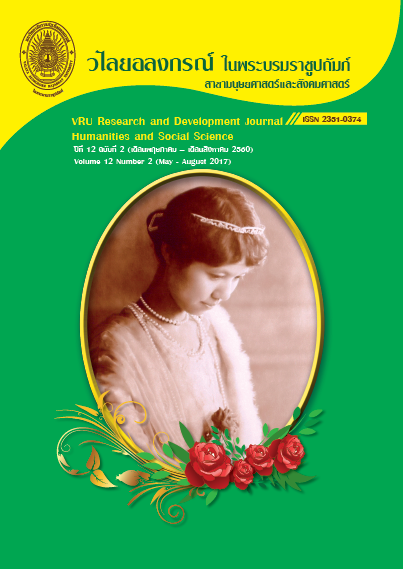การจัดการแรงงานผู้สูงอายุในประเทศไทย : ปัจจัยเชิงสาเหตุและผลลัพธ์
Main Article Content
Abstract
การเปลี่ยนแปลงของโครงสร้างประชากรผู้สูงอายุที่เพิ่มขึ้นมีผลกระทบต่อตลาดแรงงานเป็นอย่างมาก อีกทั้งแรงงานวัยหนุ่มสาวที่เข้าสู่ตลาดแรงงานก็มีแนวโน้มลดลง องค์การจึงต้องหาวิธีการรับมือกับการขาดแคลนแรงงาน ดังนั้นการจัดการแรงงานผู้สูงอายุจึงถือเป็นประเด็นที่ท้าทายขององค์การในการจัดการทรัพยากรมนุษย์ขององค์การเพื่อรับมือกับการขาดแคลนแรงงานในอนาคต โดยองค์การสามารถนำทักษะ ความรู้ ความสามารถ ความเชี่ยวชาญ และประสบการณ์ที่สั่งสมมาของแรงงานผู้สูงอายุใช้ให้เกิดประโยชน์ต่อองค์การได้ บทความนี้มีวัตถุประสงค์เพื่อนำเสนอแนวคิดเกี่ยวกับปัจจัยเชิงสาเหตุที่ส่งผลต่อการจัดการแรงงานผู้สูงอายุ ได้แก่ ภาวะผู้นำการเปลี่ยนแปลง และการจัดการความหลากหลาย พร้อมทั้งผลลัพธ์ของการจัดการแรงงานผู้สูงอายุที่มีต่อการแบ่งปันความรู้ขององค์การ และผลการดำเนินงานขององค์การ ศึกษาโดยการทบทวนวรรณกรรมจากแหล่งต่างๆ อาทิ ตำรา บทความวิชาการ บทความวิจัย เพื่อเป็นประโยชน์สำหรับการนำไปประยุกต์ใช้ในการดำเนินงานด้านการจัดการแรงงานผู้สูงอายุในองค์การ และเพื่อศึกษาเชิงประจักษ์ในอนาคต
The changes in the aging population structure have had a significant impact on the labor market. Young people entering the labor market are also likely to decline. The organization must find ways to cope with labor shortages. Therefore, the management of the elderly workforce is a challenge for the organization to manage its human resources to cope with future labor shortages. Organization can bring skills, knowledge, ability, expertise and the accumulated experience of elderly workers is beneficial to the organization. This article aims to present the idea of the causal factors of elderly workers management including; transformational leadership and diversity management, moreover to present the effect of knowledge sharing organization and Organizational Performance. This paper studies by reviews literature from various sources such as textbooks, academic papers and research papers, in order to apply this concept in organizations and provide for empirical study in the future.
Article Details
ลิขสิทธิ์บทความวิจัยที่ได้รับการตีพิมพ์เผยแพร่ในวารสารมนุษยศาสตร์และสังคมศาสตร์ วไลยอลงกรณ์ ในพระบรมราชูปถัมภ์ ถือเป็นกรรมสิทธิ์ของคณะมนุษยศาสตร์และสังคมศาสตร์ มหาวิทยาลัยราชภัฏวไลยอลงกรณ์ ในพระบรมราชูปถัมภ์ ห้ามนำข้อความทั้งหมดหรือบางส่วนไปพิมพ์ซ้ำ เว้นแต่จะได้รับอนุญาตจากมหาวิทยาลัยเป็นลายลักษณ์อักษร
ความรับผิดชอบ เนื้อหาต้นฉบับที่ปรากฏในวารสารมนุษยศาสตร์และสังคมศาสตร์ วไลยอลงกรณ์ ในพระบรมราชูปถัมภ์ เป็นความรับผิดชอบของผู้นิพนธ์บทความหรือผู้เขียนเอง ทั้งนี้ไม่รวมความผิดพลาดอันเกิดจากเทคนิคการพิมพ์
References
เกื้อจิตร ชีระกาญจน์. (2557). การจัดการทรัพยากรมนุษย์ในธุรกิจสมัยใหม่ (ปัจจุบันสู่อนาคต).
วารสารสุทธิปริทัศน์. 28(86), 322-337.
เฉลิมพล แจ่มจันทร์. (2556). ข้อพิจารณามโนทัศน์ใหม่ของ “นิยามผู้สูงอายุ” และ “อายุเกษียณ” ในประเทศ
ไทย. วารสารประชากร. 4(1), 131-150.
ประไพศรี ธรรมวิริยะวงศ์. (2559). การจัดการความหลากหลายของบุคลากรในองค์การ. วารสารวิชาการ
มหาวิทยาลัยกรุงเทพธนบุรี. 5(2), 1-12.
พิมลพรรณ เชื้อบางแก้ว. (2555). การบริหารทรัพยากรมนุษย์ Human resource management.
พิมพ์ครั้งที่ 3. ปทุมธานี: มหาวิทยาลัยกรุงเทพ.
พรรัตน์ แสดงหาญ. 2558. การจ้างงานผู้สูงอายุในประเทศไทย. สถาบันทรัพยากรมนุษย์
มหาวิทยาลัยธรรมศาสตร์. 10(2), 94-104.
นลวัชร์ ขุนลา และ เกษราภรณ์ สุตตาพงค์. (2558). การจัดการความรู้สู่การสร้างองค์กรที่ประสบ
ความสำเร็จ. วารสารนักบริหาร. 35(1), 133-141
วนิดา วาดีเจริญ และคณะ. (2556). การจัดการทรัพยากรมนุษย์ จากแนวคิด ทฤษฎี สู่ภาคปฏิบัติ.
กรุงเทพฯ: ซีเอ็ดยูเคชั่น.
วรเมศม์ สุวรรณระดา. (2559). ชาญชรา ก้าวสู่สังคมสูงวัยด้วยความรู้และปัญญา. กรุงเทพฯ:
สำนักงานกองทุนสนับสนุนการวิจัย.
สมพิศ ทองปาน. (2559). HR เชิงรุกในยุคของการเปลี่ยนแปลง. วารสารบัณฑิตศึกษา. 10(3), 245-258.
Alessandra Lazazzara Maria Cristina Bombelli, (2011),"HRM practices for an ageing Italian
workforce: the role of training", Journal of European Industrial Training, Vol. 35 Iss 8 pp. 808 – 825.
Bhaskar, Rahul and Yi Zhang. (2007). Knowledge Sharing in Law Enforcement: A Case Study.
Journal of Information Privacy & Security, 3(3), 45-68
Chen, J. et al (2010). Factors related to well-being among the elderly in urban China focusing
on multiple roles. BioScience Trends, 4(2), 61-71.
Chen, L., & Fong, P. S. (2012). Revealing performance heterogeneity through knowledge
management maturity evaluation: A capability-based approach. Expert Systems with Applications. 39(18), 13523-13539.
Chui, W. C. K., Chan, A. W., Snape, E. and Redman, T. (2001). Age stereotypes and
discriminatory attitudes towards older workers: An east-west comparison. Human Relations. 54(5), 629-661.
Daft, R. & Marcic, D. (2013). Management: The new workplace. 8th ed. Canada: South-Western Cengage Leaning.
De Clercq, Dirk, Dimo Dimov, and Narongsak Tek Thongpapanl. (2010). The moderating impact of internal social exchange processes on the entrepreneurial orientation-performance relationship. Journal of Business Venturing 25. 1: 87-103.
Dirk Buyens, Hans Van Dijk, Thomas Dewilde ans De Vos. (2009). The aging workforce:
perceptions of career ending. Journal of Managerial Psychology. 24(2), 102-117.
Dychtwald et al. (2006). Workforce Crisis: How to Beat the Coming Shortage of Skills
and Talent. Harvard Business School Press, Boston.
Fellow, E. W. (1956). A study of factor related to a feeling to happiness. Journal of Education Research, 50, 231-234.
Foss, N. J., Husted, K., & Michailova, S. (2010). Governing Knowledge sharing in organization: Levels of analysis, govermance mechanisms, and research directions. Journal of Management struies, 47(3), 455-482.
Gharakhani, D., & Mousakhani, M. (2012). Knowledge management capabilities and SME’s organizational performance. Journal of Chinese Etrepreneurship, 4(1), 35-49.
GÖKÇEN, AYSE. (2012). “Dıversıty in Dıversıty Management.” International Journal of
Business and Social Science 3, 19 (October): 241-244.
Jantana Sansook. (2010). Strategic customer relationship management capabilities and market performance: An empirical study of private hospitals in Thailand. Ph.D. Dissertation (Management). Mahasarakham University.
Kasia Karpinska, Kene Henkens, Joop Schippers and Mo Wang. (2015). Training
opportunities for older workers in the Natherlands: A Vignette Study.
Research in Social Stratification and Mobility. 41, 103-112.
Lebans, M., & Euske, K. (2006). A conceptual and operational delineation of performance, Business Performance Measurement. Cambridge University Press.
Lin, Hsiu-Fen (2007). Knowledge sharing and firm innovation capability: an empirical study. International Journal of Manpower, 28(3/4), 315-332.
Nada, K. K., Alexander K., & Andrew K. (2001). From tacit knowledge to knowledge management: Leveraging invisible assets. Knowledge and Process Management, 8(3), 137-154.
Noe, R. A., Hollenbeck, J, R., Gerhart, B. & Wright, P. M. (2012). Human resource management: Gaining a competitive advantage. 8th ed., New York: McGraw-Hill/ Irwin.
Oluwafemi Oyemomi, Shaofeng Liu, Irina Neaga and Ali Alkhuraiji. (2016). How knowledge sharing and business process contribute to organizational performance: Using the fsQCA approach. Journal of Business Research. 69, 5222-5227.
Ozgener, Sevki. (2008). “Diversity Management and Demographic Differences-based Discrimination: The Case of Turkish Manufacturing Industry.” Journal of Business Ethics, 82, 621-631.
Pinto, Silva Ramos and Nunes (2014). Managing an aging workforce: What is the value of human resource management practices for different age groups of worker? .Review of Applied Management Studies. 12, 58-68.
Ruta Ciutiene and Rasa Railaite. (2014). Challenges of managing an ageing workforce. Procedia-Social and Behavioral Sciences. 156, 69-73.
Shirbekk, V. (2008). Age and productivity capacity: Descriptions, causes and policy options.
Aging Horizons, 8, 4-12.
Tiwana, A. (2001). The Essential guide to knowledge management. New Jersey, NJ Prentice
Hall.
Viroj Jadesadalug. (2009). “Building Innovative Creation Efficiency of Furniture Business in
Thailand: An Empirical Research of Its Antecedents and Consequences. Ph.D. Dissertation (Management), Mahasarakham University.
Youndt, M. A., Subramaniam, M., & Snell, S. A. (2004). Intellectual capital profiles: an
examination of invesstments and returns. Journal of Management Studies, 41(2),
-361.
Zhining Wang, Pratyush Nidhi Sharma and Jinwei Cao. (2016). From knowledge sharing to firm
performance: A predictive model comparison. Journal of business research. 69,
-4658.


